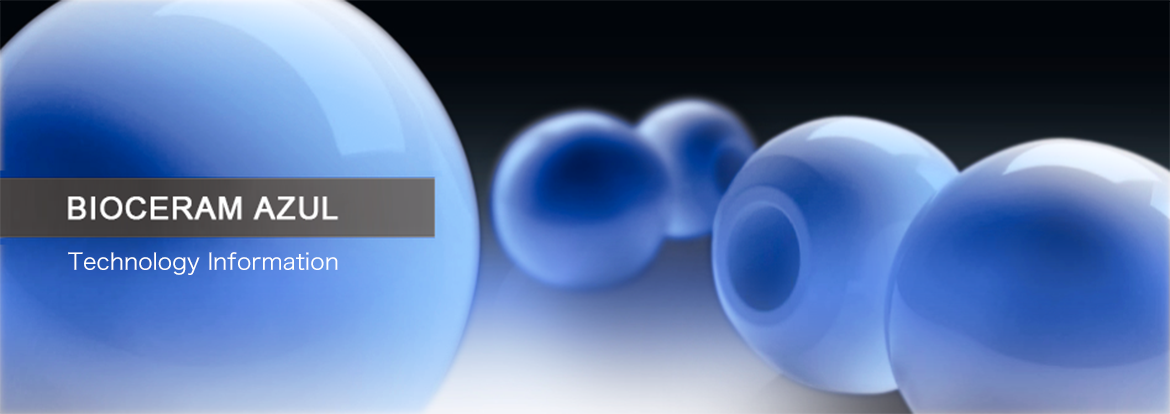

BIOCERAM AZUL
The development of BIOCERAM AZUL began in 2000. Based on zirconia, which had already been commercialized at the time, development was carried out under the slogan "Aiming for Strength 2000MPa." Zirconia is superior in strength to other materials, and Kyocera alone has succeeded in commercializing zirconia as a product that can be used safely by patients; it has been on the market for more than 10 years to date. However, using this zirconia as a base, preparation and testing of the prototype were repeated many times, resulting in unsatisfactory quality.
Under such circumstances, in 2002, development entered a new phase, starting with new idea that changed our way of thinking. The new concept involved using high-purity alumina as a base reinforced with zirconia. Alumina is a material that we developed ahead of zirconia and has excellent long-term stability in clinical settings. Based on this alumina, test results were favorable, and development proceeded smoothly, eventually leading to the commercialization of the product under the name BIOCERAM AZUL.
The secret to BIOCERAM AZUL's excellent mechanical properties and stability lies in the mix ratio for alumina and zirconia. The mixing ratio of 8:2, which has been studied extensively, has proven to enhance the performance of each component and achieves the best balance to compensate for their disadvantages [Fig. 1].
[Fig. 1] Characteristic comparison of materials.
BIOCERAM AZUL is a highly reliable ceramic material which has approximately twice the strength of high-purity alumina and has more fracture toughness than zirconia.
BIOCERAM AZUL also has strong resistance against external stresses and impact.
| Item | Unit | BIOCERAM AZUL | Zirconia (BIOCERAM ZR195) |
High‐purity almina (BIOCERAM AL190) |
|---|---|---|---|---|
| Four-point bending strength | MPa | 1400 | 1450 | 600 |
| Fracture toughness value (IF method) |
MPa・m0.5 | 4.5 | 3.8 | 3.4 |
| Hardness | Hv | 1740 | 1400 | 1900 |
As seen in Figure 2, the uniform mixing of the two materials is key to achieving excellent mechanical properties and stability.
BIOCERAM AZUL zirconia particles are surrounded by high-purity alumina particles with a high Young's modulus. As a result, concerns about the crystal phase transition (low-temperature degradation) of uniformly dispersed zirconia particles in body fluid were eliminated, and because the particle size is finer, it enables a more uniform dispersion of the two materials and further enhances stability and strength.
[Fig. 2] Crystalline photograph of BIOCERAM AZUL
The alumina and zirconia mixing ratio is 8:2, and the uniform dispersion and fine particle size of zirconia particles are strictly controlled. As shown on the right![]() , zirconia particles are bound by alumina particles.
, zirconia particles are bound by alumina particles.

Techniques to control these particles (mixing ratio, uniform dispersion, and particle size) at the nano level have enabled us to achieve extremely high strength and toughness, and to maintain their properties in the long term [Figure 3].
[Fig. 3] Stability of BIOCERAM AZUL strength
No reduction in intensity was observed after exposure to 134°C saturated water vapor for 50 hours. Also, no change in the zirconia crystalline phase (tetragonal to monoclinic phase transition) has been observed. Therefore, BIOCERAM AZUL can achieve long-term stability.

In addition, while conventional ceramic materials used in artificial joints are diverted from general industrial ceramic materials for industrial products, BIOCERAM AZUL has been developed as a material for artificial joints that serve as medical devices. For this reason, we decided to design materials that fully take into account the safety of additives. Furthermore, research has been conducted without compromise in order to maximize the properties required for ceramic materials for artificial joints.

Ceramics are essential materials for people's daily lives and for the broader industrial economy, with applications ranging from everyday items such as pottery to high-tech fields such as mobile phones and space development. Not only theory but also many years of experience and human sensibility are important for doctors in the advancement of technology using this ceramic material.
Inheriting the wisdom of Japan by focusing on the safety and durability of ceramics through many years of technological development, we have developed BIOCERAM AZUL as a material for artificial joints.
There is a strong desire to improve the quality of life for patients as the basis for BIOCERAM AZUL's development. BIOCERAM AZUL has led to the development of products that do not compromise on quality. What is more pleasurable is that patients can walk actively again and share their feelings of enthusiasm.